March 11, 2015
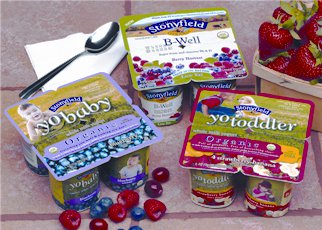
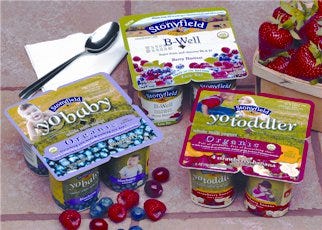
stonyfield beauty by TJH
Organic yogurt company Stonyfield Farm, Londonderry, NH, debuts what the company says is the first yogurt cup to be made from plants. The new packaging is made using Ingeo bioplastic resin from NatureWorks LLC and is being used for the company's multipack yogurts: YoBaby, YoToddler, YoKids, B-Healthy, B-Well, Probiotic and O'Soy.
Bioplastic packaging has been of special interest to Stonyfield for more than a decade. "We initially looked at PLA back in the late 90s," says Nancy Hirshberg, vp of natural resources for Stonyfield. "At that time, the NatureWorks' PLA was only in prototype form and they had not built the Nebraska facility."
So Stonyfield was more than willing to listen to Clear Lam Packaging Inc., when the packaging converter called on them, saying that advances in bioplastics coupled with the converter's own research and development capabilities has made PLA a commercially feasible packaging option for its horizontal form/fill/seal (hf/f/s) dairy packaging operation.
"The process started about two years ago," says Roman Forowycz, group president and CMO of Clear Lam. "PLA in and of itself has some positive and negative attributes; it is relatively brittle, and it has low temperature resistance. That's why the materials have to be modified with other ingredients that will enhance performance characteristics. NatureWorks makes the base resin for this packaging, and there are three-plus components that we developed internally in our labs that enhance the material for this specific application."
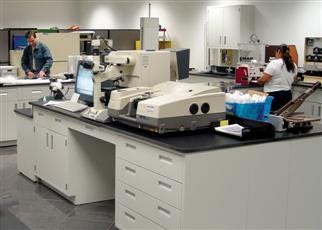
Clear Lam lab
To determine the needs for this particular application, Clear Lam worked in concert with both Stonyfield and with its form/fill/seal machinery manufacturer Arcil. These learnings were used to develop PLA-based packaging material and to optimize Stonyfield's hf/f/s machine to work with the bioplastics material web.
"Most of the dairy industry for yogurts uses high-impact polystyrene (HPS) as the base sheet, and [over the years] these lines have been optimized to run HPS," says Forowycz. "The relationship between the materials supplier and the equipment supplier is critical in any of these new applications."
Facilitating outside innovation
This was not a simple machine conversion for Arcil. There were four major optimizations that had to be achieved in this project," Vincent Altazin, U.S. sales manager for Arcil, explains: The parameters were the temperature the heating box; the flatness of the heating box; the type of forming punchers; and the temperature of the molder for good adhesion with every inset label."
He says that the three-party partnership wasn't always easy but very successful. "We had results on time for development, and open new ways of forming, filling and sealing packages."
At the center of the partnership between materials supplier and equipment manufacture is Stonyfield's own packaging team: Rolf Carlson, vp of sourcing and product development; Jack DiMartino, packaging manager in the research and development group; Derwin Flannery, maintenance manager; and Kevin Young, performance manager.

horizontal ffs machine
Carlson has been in the dairy industry 25 years, primarily in the cultured products segment. He served as the executive team sponsor facilitator for the project. "I would say as facilitator, my job was to make sure that the team is able to perform at their optimum level, which means basically to make sure the barriers were removed and resources were provided," he explains.
RIT-trained packaging engineer DiMartino has 15 years of technical experience, including work in the coffee group for Kraft Foods Inc. He coordinated the trials themselves, working very closely with Young and the company's maintenance department to optimize work with the many different vendors on this project.
Young holds a degree in industrial engineering and has 15 years of experience doing lean manufacturing continuous improvement activities. "I basically was the organizer/liaison," he explains. "I worked with Derwin to organize line times for trials and make sure everybody was aware of what was going on."
Flannery is a former nuclear machinist mate for the U.S. Navy and is qualified to work on nuclear reactors and also has a strong background in thermodynamics and metallurgy. As part of his duties as maintenance manager is Stonyfield, Flannery is responsible for maintaining the equipment and the setpoints and therefore controls the modifications and timing for the equipment.
"We had a small team here-a good, cross functional, representative, technically astute team-but at the same time we brought in our equipment supplier, Arcil; we brought in the materials suppliers, Clear Lam, which provides U.S. with the roll stock, Bemis Co., Inc. which provides the labeling, and Winpak Ltd., which supplies the lidding," Carlson explains. "We worked together; we weren't bringing them in one by one; we worked as a team."
Stonyfield also planned for the time and the demands on internal and external resources for this project. "We asked manufacturing to reserve line time for the next trial in so we could make changes or adjustments. We also ask our suppliers and equipment manufacture to reserve time for follow-up. We told our suppliers that we would want them to make necessary adjustments, provide new packaging materials, or print new materials for that next trial. We also knew that if we were testing something that the outcome of the trial might result in some modifications."
Carlson also had to determine the likelihood of the projects success early on. "If the project wasn't going to bear fruit, I want to return resources to their other jobs so that they can work on other projects," he explains. "If something doesn't pan out, well that's fine. That's part of innovation; it's part of trying to come up with new packaging or new products."
This time, the PLA project, started to show promise early.
"We had three trials at the end of last year between September and December," DiMartino explains. "But once we got into our trial at the end of January, I think that was really the first time that people start to believe."
This belief in the project was demonstrated by both internal and external team members. Suppliers began eagerly developing solutions for the projects challenges, and the Stonyfield team members explored all options whether they are new or old.
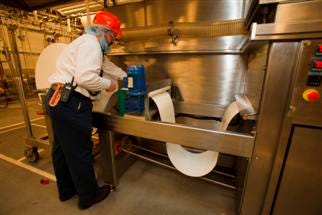
PLA material web being fed into machine
"Our label supplier made all these incredible different types of labels to help the adhesion process," Flannery recalls. "But nothing was working." Instead of being frustrated and giving up, Stonyfield team kept asking for more options. The solution came from a past development not a new one. "Then we said, why don't we try our old labels, and they worked pretty well."
Stonyfield wasn't willing to sacrifice quality for the sake of finishing the project, though. "We were ready to launch this spring without making any investment or machinery but it just wasn't perfect," says Hirshberg. "We decided let's not go and do this and have the packaging looks shabby or be bad. So we made the investments to make sure the packaging was perfect."
New packaging process
The PLA-based packaging material is supplied by Clear Lam as a web. This web is fed into a Arcil A6 hf/f/s machine. To accommodate the hardness of PLA, Stonyfield adjusted the clips that prick the rolls to guide the material into the machine. Stonyfield and Clear Lam also refined the material gauging and the ratio of the layers in the web for optimal performance in the A6.

label web
The roll stock is heated to 180-deg F by platens just prior to moving to the cup-forming area. This is another sustainability win because 280-deg F is needed to HPS cups, but it was hard won.
"We actually had to change the platens to be a different shape and design so they would have a different heating or thermal development on the rolls," Carlson explains, "and we decreased the air pressure used in the forming process but increased the volume used." Air pressure and cup forming plungers are used to extrude cups from the sheet.
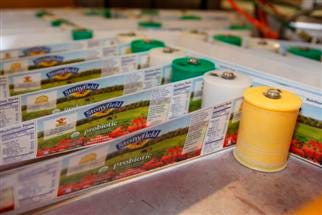
label web cut into strips
Labeling material is inserted into the molds prior to cup forming. Prior to insertion, the approximately 3-ft-wide web of labeling material is cut into 12 strips. Individual labels are cut from these strips, made into a circle and then inserted into the mold. To adhere the labels to the cups, a mold is rotated over the form of plastic, which is still a warm 175-deg F. The sheet of cups then are cooled and moved to the filling station. The entire cup-forming process takes less than two seconds.
In-mold labeling enables Stonyfield to minimize packaging materials used without sacrificing pack strength. "The way it was explained to me many years ago, it's almost like plywood," Carlson remarks. "You can thin-wall it but still have a strong container from the compression. In-mold labeling not only brings the beauty of gravure printing but also a strong package.
Harry Marovskis, director of sales for Synerlink USA, which is a cooperative effort between Arcil and Tecma Pack to serve U.S. packaging operations with complete packaging lines and equipment, adds that in-mold labeling can save warehouse space and the costs associated with the real estate. "The warehousing of raw materials is quite a bit less than having preformed cups that are out there," he explains. "A label reel can last eight hours in production. If you were to store to eight hours of production on a label with preformed cups, you'd have to have a truck full of cups to warehouse that."
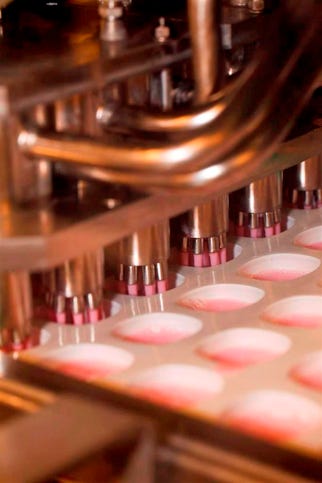
Yogurt being dispensed into cups
The cups are filled with fruit and milk, covered by a web of metalized PS and sealed using a combination of UV light, offering a sealing temp of 425 deg F, and pressure." On the sealing tool, you have two parts: the first heats the material around the cup and the second is a ring that puts high pressure on the plastic," Altazin explains. "The heating temperature and the hardness of the PLA are not the same [so equipment adjustments needed to be made.]" Additionally, Winpack had to adapt the lidding with a new sealant for better adhesion to the PLA-based packaging.
Sealed cups are cut into multipacks, and scores are placed between individual cups to allow consumers to break apart the single-servings. Optimization of the knives used is an ongoing challenge for Stonyfield. Carlson explains, "Our previous setup used knife that had an average Rockwell hardness of 55; it was a 440C stainless that was being used for the knives. But this [packaging] material is harder and tougher. One of our biggest challenges is cutting and scoring of the packages and the rapid dulling of the knives."
A Markem-Imaje Intl printer then date codes the packaging as well as notating the production line used. A Tecma Pack case packer erects wraparound cases, packs them with yogurt containers, and seals them. Intralox LLC conveyors move packaged product throughout Stonyfield's facility.
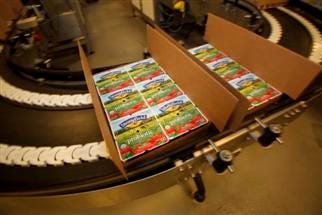
filled packages being case packed
Product pallets are built by an Intelligrated Inc. Alvey machine before being moved into Stonyfield's incubator. Product cases have die-cut holes that allow the heat to pass between the cups during incubation process, which can take up anywhere from four to six hours, and enable cold air to pass through during the cooling process, which takes between two to three hours.
After the product pallets are incubated and cooled, they have stretch wrap applied by one of Stonyfield's Wulftec Intl Inc. or Lantech wrappers.
Room for improvement
The package and packaging line improvement project begin in September 2009, and Stonyfield started phasing in the bioplastic packaging in October 2010. "I am extremely proud with the speed of development and being able to commercialize this project in a little over 12 months," remarks Carlson.
Stonyfield hasn't stopped working to optimize its packaging operations or the multipacks themselves. Carlson notes that the team is now looking at harder more durable knives as well as various coatings and types of steel that might retard dulling of the scoring- and cutting-knives.
Although Stonyfield reduced by half the amount of packaging materials used for lidding, it also is looking at more sustainable alternatives for its lidding material. "Our 4-oz package is 81 percent biobased, according to the ASTM Intl's D6866 standard [10 Standard Test Methods for Determining the Biobased Content of Solid, Liquid, and Gaseous Samples Using Radiocarbon Analysis]," remarks Carlson. "The PLA material is 93 percent biobased; 7 percent of the master batch is colorants and additives. Our paper labels are 87 percent biobased. But our lidding right now is 0 percent biobased."
Hirshberg adds, "Right now the lidding material is being recovered. We're collecting all our scrap from facilities to recycle. We really need to switch over that lidding to biobased materials, and we want to be in PLA for the lidding because the package then can be recycled together and the lidding is no longer a contaminant."
Stonyfield also sees room for improvement in the feedstock that is used for Ingeo. "Stonyfield has been willing to tweak, roll up their sleeves and make it work," remarks Steve Davies, marketing and communications director for NatureWorks. "They went into this with their eyes wide open that it isn't perfect today."
Because Stonyfield is concerned about the environmental effects of genetically modified corn grown conventionally, it has invested in the Working Landscapes certificate program that is operated in partnership by the Institute for Agriculture and Trade Policy (IATP) and Green Harvest Technology. "It's sort of like buying wind power," Hirshberg comments. "You don't know that the electron you purchased is going to end up in your house powering your iron but it's something you've paid for that's on the grid. [In the same way,] we don't know if that corn is going to end up in high-fructose corn syrup or in the lactic acid that becomes Ingeo or whatever." The Working Landscapes offset program that Stonyfield participates in produces a sustainably grown amount of corn equal to the amount used for the cups. Thus, by taking an equivalent amount of GMO corn out of production, Stonyfield is not supporting GMOs.
Stonyfield estimates that it will take 490 acres of feedstock corn, which differs from the sweet corn used for human consumption, to make bioplastic packaging for its first year of commercialization. Through this program, it's paying farmers $74/acre to grow the corn using more sustainable agricultural practices. This comes out to an investment of $40,000, most of which would go directly to the two farmers from which it has contracted.
"This money is an incentive to drive farmers to what we think are more sustainable processes," Hirshberg explains. "Using the market in this way encourages not only better practices but gets more money to the pockets of these farmers. You know what shocked me was economic stress these farmers are under. And so for me, returning more money to these farmers is really important.
"We could have bought lactic acid from other places in the world and made the pellets from that," she continues. "But we just felt it was a much better thing to do is move American farmers to what we think are more sustainable practices and then do it that way."
NatureWorks is working on a solution for better feedstock sourcing on an international level. "With our current growth rates, which are 25 to 30 percent a year typical, we anticipate that first plant [located on the Cargill site in Blair, NE] will be in full operation in a three-plus year timeframe," Davies explains. "Given that, we've already embarked on a search assessment globally on where should the second plant location go. [We are asking ourselves,] should it be an in-kind installation in Blair; should we expand Blair? So we're looking at Brazil, Europe and locations in Asia. Were the next plant to go to Europe, it [the feedstock] would be sugar beet. In Brazil, sugar cane obviously. And the various locations around Asia be it Thailand, Malaysia or Singapore, We're really immersed in where it [the next plant] should go, what the local incentives are from different countries around the world that want to jump start their economies and bring biobased jobs; we're doing that assessment now."
Stonyfield is also working on better end-of-life options for the packaging. "We're not claiming compostability," Carlson remarks, "because the material is thicker and our big view to move to sustainable systems looking for bio-based renewable recycled content."
Hirshberg adds that research into using hydrolysis to return PLA to lactic acid is something Stonyfield is watching closely. "That lactic acid can be made right back into PLA pellets," she explains. "You cut out the virgin crop stuff, and this is completely closed loop. It can be done over and over and over. There's no downcycling [which can degrade some of the plastic's attributes]. It has enormous potential, so we're working with two locations, one in Belgium and one in Wisconsin, to really fine-tune the process with our packaging."
Stonyfield also hopes that its "open source" approach to package development and packaging operations optimization will move bioplastics forward. This can have wide-ranging consequences for both packaging and nonpackaging-related industries. "It [Ingeo development] started with packaging by design," remarks Davies. The resin manufacturer used the simpler converting process for packaging to learn more about how the material behaves when converted, and it is now using these findings for industries as varied as foodservice to durables to disposable diapers."
Clear Lam Packaging Inc., 847/439-8570. www.clearlam.com
Arcil Group, 763/390-0891. www.arcil.fr
ASTM Intl, 610/832-9500. www.astm.org
Bemis Co. Inc., 920/727-4100. www.bemis.com
Green Harvest Technology, 917/359-9623. www.greenharvesttechnology.com
Institute for Agriculture and Trade Policy (IATP), 612/870-3430. www.iatp.org
Intelligrated Inc., 866/936-7300. www.intelligrated.com
Intralox, LLC, 888/427-2358. www.intralox.com
Lantech, 800/866-0322. www.lantech.com
Markem-Imaje Intl, 770/421-7700. www.markem-imaje.com
NatureWorks LLC, 952/742-0400. www.natureworksllc.com
Synerlink USA, 763/390-0891. www.arcil.fr
Tecma Pack, +33 1 64 04 51 80. www.tecma-pack.fr
Winpak Ltd., 450/424-0191. www.winpak.com
Wulftec Intl Inc., 877/985-3832. www.wulftec.com
About the Author(s)
You May Also Like


